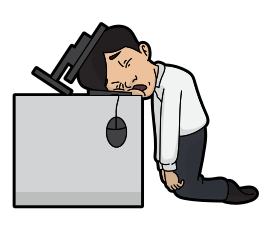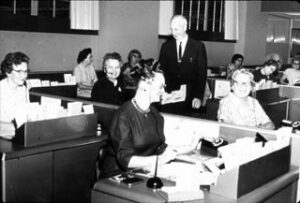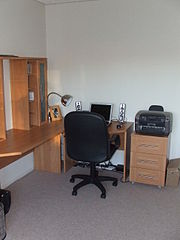
Long ago, before public health measures to reduce the spread of COVID-19 sent workers home, about 50 per cent of Americans in the work force spent their days in an office, either in cramped open spaces or small cubicles spread out across a large room. During my early employment history, I worked in large desk-filled room. I had an adding machine, a electric typewriter, which was considered high-tech at the time, and a telephone that could not take a message. Cabinets filled with 3 x 5 cards lined one wall. The supervisor had a small, individual office. No wonder I decided to go back to graduate school.

Office workers have existed throughout history. Up until the 19th century they were predominantly male. The invention of the typewriter opened up the profession to women after men concluded they didn’t want to be tied to a clacking machine. Fair enough.

Over time, offices filled with women as Mad Men so eloquently illustrated. Naturally, women were supervised. But even men with individual office space required some level of supervision. Because, if no one watched the workers, it was assumed they wouldn’t work as hard. To be fair, remote work wasn’t a viable proposition, because there was no technology to support it.

So, every morning, office workers dressed professionally, commuted to the office building, piled into elevators, and made their way to work stations. Technology changed. Workers acquired personal Blackberries. Computers meant no one needed a secretary. Printers made typists obsolete. The office itself became an anachronism taking up expensive real estate. But both workers and clients considered it a necessary symbol of a company’s success.
Enter COVID-19

Office workers went home. They learned teleconferencing software and communicated via email and texts. They discovered how much more comfortable it was to work in leisure wear — in some cases, they stayed in pajamas all day, at least at the beginning. There was no one to see how they looked unless there was a Zoom meeting. After two years, data indicates that under these conditions, productivity, rather than declining, remained the same or slightly increased. Employees spent about half an hour more per day on the job, and in 2020, world productivity output increased 5 per cent.

Remote work offered employees an opportunity to change their personal situations without harming productivity. Many moved away from crowded city housing, because they were no longer subject to a daily commute. Extroverts found ways to connect socially outside the job. Introverts flourished.
Hi-ho, Hi-ho Is it back to the office we go?
The pandemic ebbed. People got vaccinated. Now managers want people back in the office. Elon Musk told his employees to return to the office for 40-hours a week, or quit. Apple executives came up with a hybrid plan to return employees to the office three days a week. Citigroup, Google, and American Express offered a similar office structure. Come in to the office three days a week; work from home the other two. Sound like a reasonable compromise?

Perhaps not. Seventy-six percent of Apple workers disliked the new schedule. Fifty-six percent began looking for other jobs. Even some executives resigned. Turns out, many workers now prefer working from home where they claim a greater degree of focus, lower stress levels, and a better work-life balance. Other objections include being available for a pandemic pet that joined the household, rejection of the daily commute, and health-related concerns.
Besides, it won’t be the same office. Mindful of social distancing, the space will be more spread out. And people may not select the same days to go to the office. If one person goes to the office, only to find no one else on the team is present, the employee will spend the day looking at a screen, just like working from home. Clearly, some organizational scheduling will have to take place.
Sometimes employees go into the office, but upper management is absent. Not a good message for building morale.
And if everyone shows up, how will they make the transition from the home office to interacting with managers? Foil Arms and Hog offer a humorous scenario.
Illustrations
Exhausted Worker. Free Clip Art.
Patent Office Examiners at Work.
Seattle City Light Office Workers, 1973. Seattle Municipal Archives.
Trollback + Company Office by Trollbackco.
Home Office by Stubacca.
Zoom Work Meeting on Clubture@20 Project by Zblace.
Office Room by Jahnab91.
Maria Akhter. “5 Reasons Employees Don’t Want to Return to the Office.” Envoy. May 3, 2022.
Rani Molla. “Why the return to the office Isn’t Working.” Vox. June 10, 2022.
Joanna York. “The Double Standard of the Return-to-Office.” BBC. June 6, 2022.

Sandra Wagner-Wright holds the doctoral degree in history and taught women’s and global history at the University of Hawai`i. Sandra travels for her research, most recently to Salem, Massachusetts, the setting of her new Salem Stories series. She also enjoys traveling for new experiences. Recent trips include Antarctica and a river cruise on the Rhine from Amsterdam to Basel.
Sandra particularly likes writing about strong women who make a difference. She lives in Hilo, Hawai`i with her family and writes a blog relating to history, travel, and the idiosyncrasies of life.

